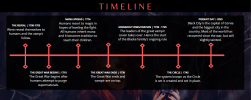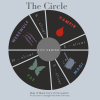Magi, also known as Spellcasters, are humans who know the art of magic. Witches, wizards, warlocks, sorcerers, etc. They are large in population, though there are many of those in their Slice who do not know the art of magic. These people are called
Normies. Still, they are considered Magi because all humans are born with mana. Their people did a lot of damage in the war and could have won if it were not for their greater mortality.
In Cervia, most Magi fall under the category of
House Magi, meaning they belong to one of the nine elemental Magi houses. If one is not part of one of those houses, they are considered a
Rogue Magi.
Rogue Magi are usually small families or teachers passing on their unique magic to students. They are easily overlooked because of their small-scale groups. Like the houses, they have their own spellbook and way of practicing magic.
WEAKNESSES
All Magi share the same weaknesses:
Mortality: Magi are the second weakest creatures when it comes to mortality and their bodies. Too many things can harm and kill them. After all, they're still human. Because of mana, Magi live to be about 150 years on average.
There is always a price: Magic always has a price, and in the case of the Magi, it's usually insignificant things such as some of their mana, which they can regain through rest. However, the bigger and more powerful the spell, the bigger the price.
Magic: Stronger magic can overcome weaker magic. In some cases, magic may be unpredictable. Without experience, skill, and knowledge, magic can be useless or extremely dangerous to the Magi and those around them.
Magic Resistance: This can foil any Magi's magic. Fae have magic resistance, but only their bodies are protected.
Black Magic: Black magic, or the dark arts, is the most dangerous magic of all. Hence why it is highly illegal. While regular magic uses the user's mana, black magic uses the life force around them, leaving living creatures to die and decay. It is what caused major harm in the Great War.
ABILITIES
All Magi possess these abilities:
Mana: The impersonal source of energy existing in people, places, and objects. Only Magi can obtain and manipulate it, and with it, they can cast spells and create potions.
Spellbook: Every Magi has a spellbook in their family, passed down from generation to generation. Every spellbook contains spells, incantations, enchantments, potion recipes, information, etc. What adds to the specialness of family spellbooks is that they are "alive." Some speak and answer questions, others may move close to their owner when they're not looking or flip through their pages for them.
A piece of every family member is in the spellbook, helping to guide the next wielders. This is because, on every tenth birthday, humans sign their names in the book. There is a whole ceremony for it, and it is not taken lightly. Once they sign their name, the human's mana is boosted, and they become an official Magi.
One can buy little spellbooks and scrolls from the store, but none of it amounts to a family spellbook.
Magic Tools: Charms, relics, and items can be used by anyone, but only Magi can make them, break them, or change them. It is their mana that makes these items.
Potions: Like magical tools, only Magi can make and alter potions. It is their mana that makes them work.
((Many definitions are taken from Superpower wiki))
THE NINE HOUSES (RANKED BY PRESTIGE)
House of Sanguis: Blood Magic –
House of the current Magi Commissioner
House of Spiritus: Spirit Magic
House of Lux: Light Magic
House of Tenebris: Darkness Magic
House of Ignis: Fire Magic
House of Aqua: Water Magic
House of Terra: Earth Magic
House of Ventus: Wind Magic
House of Viridi: Plant Magic
HOUSE CONNECTIONS
Special Friendships
1.
The Trinity: blood, bone, and shadow. Sanguis, Spiritus, and Tenebris have been close-knit since the beginning of time. Their magic is related to the self, and once upon a time, they were all seen as a dark and horrifying type of magic. Shared histories and ideas drew them together and keep them together.
2.
The Triad: earth, water, and plant. They support one another and create life in ways the others never could. Mutual respect and need for one another have made them close and continue to do so.
3.
The Trio: light, fire, and wind. It started as a duo but was turned into a trio, bridged by the house of Ignis. Fire is related to light and becomes more powerful with the wind.
Other Friendships
- Spiritus has a kinship with Viridi and Terra.
- Lux has a kinship with Viridi.
- Aqua has a kinship with Sanguis.
Rivalries
1.
Lux and Tenebris. Probably the first one, light and darkness have been around forever. One is thought of as good and the other bad. The only thing bad is the blood between them.
2.
Ignis and Aqua. They butt heads like no other, often refusing to even be in the same room as the other.
3.
Terra and Ventus. While Ventus is usually a chill house, it does not get along well with Terra at all. In most cases, they provoke them.
HOW MAGIC WORKS
While magic is a general system nearly any Magi can use, a Magi's
magic type influences how they go about performing it. Whichever magic type the Magi learns (ie. fire, water, blood, etc.),
it serves as their medium. This means the element serves as their source of mana to perform spells, potions, and other forms of magic. For example, a Blood Magi uses blood to gain and strengthen their power while a Wind Magi uses the wind.
Magi with a long line of ancestors who practiced a specific magic type have an inherited strong connection to it by birthright. This connection gives a Magi the ability to
generate and manipulate the element as well as having a natural talent and affinity for spells regarding it. For example, a Light Magi would have an easier time performing light spells than other Magi.
In many cases, those who are born into an ancestrally-inherited magic type already begin to manifest it before they start their training (ie. a fire magi may heat up objects that they touch, a spirit magi may see spirits, a plant magi may grow seeds into sprouts from touch). The stronger the connection and the less control over the abilities, a Magi's magic can even link with their emotions or state of mind.
MASTERING MAGIC
Magi typically start their training at the age of
ten, when they are deemed mentally and physically mature enough. By the time they master their first magic type, they would be in their
mid-twenties to early thirties. Learning another type of magic takes at least another
eight-ten years. But all magic has a price, and learning another type of magic has its price in resisting a new learner, more so if they are not descended from a family who uses it. If practiced poorly, it can lead a Magi to lose all of their mana or even their life.
It is important to remember that the training is strenuous, and mishaps/mistakes can lead to major side effects. The chance of them happening increases the more magic you learn. By the time you may learn a sixth magic type, you may be unable to teach anything but your core magic type.
It is also important to remember that it is next to impossible to teach someone outside of your own house. You'd have to be breaking your house rules and betraying them by passing on their secrets and knowledge. On that note, unless they sign the house book, your pupil's power in a magic type will never be as strong as those that belong to the associated house.
Rogue Magi are not so keen on teaching just anyone either, least of all someone from a house. Because they're smaller in numbers, they also like teaching someone with a clean slate (meaning someone who hasn't learned a type of magic yet). This is why, like with clans, they only teach within their family or those who they adopt into it.
It is also important to remember that you can't learn new magic without it being taught to you. Otherwise, you can seriously harm yourself or die. With all of these factors,
it is rare for a Magi to know more than one type of magic. The rare ones who do usually know two or three. If they try to pass on their magic knowledge, they would likely only be able to pass on two types due to the training time and their life span. No matter how many magic types you know, skill is ultimately the most important thing.
ALCHEMY
Alchemy is old magic, but not completely magic as it uses both the forces of magic and science. It is an art and a philosophy that stills holds mystery despite how long it has been practiced. Alchemists use spells, mana, chemical elements, and raw ingredients in their work. The practitioner's main focus is the pursuit of the magical stones (Namely the Philosopher's Stone) and transmutation. They are most adept in making poisons and potions but are unable to work with life force. They can neither create nor alter it.
For centuries the art of alchemy has been out of fashion, but with the Magi-technology starting to grow, the oldest mixture of science and magic is making a comeback as well. All Magi are able to perform alchemy, it only takes time and practice to master it. Few have.
CONDUITS
While Magi do not need conduits to perform their magic by any means, they still serve a beneficial purpose. Staffs, wands, and other similar items provide the user with additional mana. In doing so, they strengthen the Magi's spells, incantations, hexes, etc as well as stabilize them. This is because they are channeling objects.
Due to their helpful nature, many Magi children use them as a sort of crutch until they get older and no longer need them. Though there are still plenty of adults who use them, as they still work well with greater power and skill levels. Depending on how and what they're made with, some are better than others and it is about finding what personally best suits individual Magi.
FAMILIARS
Familiars are a Magi's animal companion who serves them as loyal guardians, protectors, etc. Whether consciously or not, a Magi forms a pact with the creature and binds them to them through their magic. Once bound, the animal becomes an official familiar deeply connected with its master. It feels its Magi's emotions and often mirrors their preferences and feelings, though it is still its own being and acts as it pleases unless given a command.
Magi and familiars are so deeply connected that they can understand one another without speaking. Magi are able to scry with their familiars, hitch-hiking on the senses of their familiar, but only temporarily. The stronger the Magi, the longer they may scry.
Most notably, because the magic of the Magi flows throw their familiar, a familiar has one related power that they can use at its will. For example, a Wind Magi's familiar may be able to walk on air.
BLACK MAGIC
Black Magic, aka Dark Magic, and not to be mistaken with darkness magic, is a globally banned and illegal practice. Black Magic can consist of any form of magic,
as it is magic that takes the life of living beings. Its main purpose is to cause destruction, harm, and even death.
Contrary to popular belief, Black Magic is not necessarily "evil" magic. A common belief among Magi is that there is no such thing as "good" or "evil" magic, there is only
magic. Ultimately, though, Black Magic always caused more harm than good. It is typically used for self-serving and nefarious purposes.
The more Black Magic is used, the more "corrupted" the mind becomes.
Things that are recognized as Black Magic:
1. Sacrifices
2. Curses and hexes
3. Poisonous potions
5. Cursed magical items
6. Calling on "evil" (i.e., destructive) spirits
WITCHES COUNCIL (THE NOVEM)
Handling all Magi affairs.
The council's origin story started long before the creation of Cervia, the war, and the discovery of magic by regular humans. It is a children's story; one told like a legend, a fairy tale, but a true historic tale.
It started with ten sisters. All of them were very powerful in their own right but wielded a unique magic.
The eldest sister used the blood of all living creatures.
The second used spirits that were not seen by the naked eye.
The third used the light that always came with each day.
The fourth used the darkness from every corner.
The fifth used the fire that burned matter to ashes.
The sixth used the water that covered the world.
The seventh used the ice that came every winter.
The eighth used the Earth that all walked upon.
The ninth used the air that all must breathe.
And the tenth used the plants that grew around us.
They are known as the most powerful Magi in history and the mothers of each house. Though their seventh sister died before she could extend her house or form the Witches Council with them, known respectively to Magi as
The Novem. It started off small, hidden from most and only known to Magi. They managed witches and wizards, making big and necessary decisions for magic users. During the Great War and the expansion of magic, they grew.
After the war, they became
an official government branch handling all magical affairs and cases before the court. They decide what is permitted and what is not. They have only been allowed such power because of the trickiness of magic and one of their most famous members, Owyn Treviar of House Ventus, the man who made Rockcaster habitable, was favored by the first king. Because of this, the council is located in Rockcaster.
The members of the council are nine, one chosen from each house. The government cannot interfere with the houses' decisions on who joins the council as their representative. Rogue Magi have never been on the council, but have worked beneath them.














